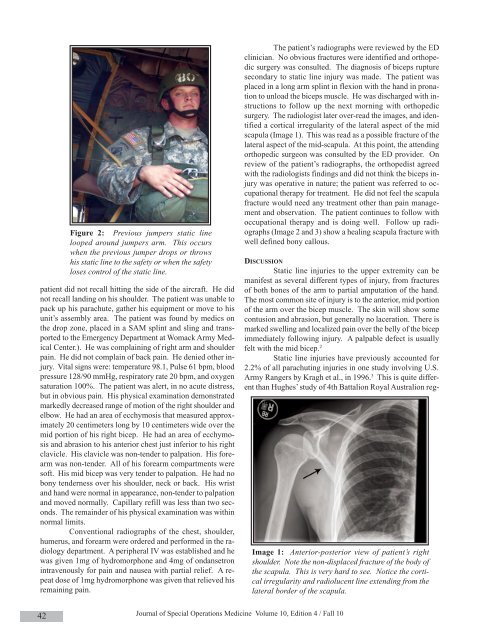Fall - United States Special Operations Command
Fall - United States Special Operations Command
Fall - United States Special Operations Command
Create successful ePaper yourself
Turn your PDF publications into a flip-book with our unique Google optimized e-Paper software.
42<br />
Figure 2: Previous jumpers static line<br />
looped around jumpers arm. This occurs<br />
when the previous jumper drops or throws<br />
his static line to the safety or when the safety<br />
loses control of the static line.<br />
patient did not recall hitting the side of the aircraft. He did<br />
not recall landing on his shoulder. The patient was unable to<br />
pack up his parachute, gather his equipment or move to his<br />
unit’s assembly area. The patient was found by medics on<br />
the drop zone, placed in a SAM splint and sling and transported<br />
to the Emergency Department at Womack Army Medical<br />
Center.). He was complaining of right arm and shoulder<br />
pain. He did not complain of back pain. He denied other injury.<br />
Vital signs were: temperature 98.1, Pulse 61 bpm, blood<br />
pressure 128/90 mmHg, respiratory rate 20 bpm, and oxygen<br />
saturation 100%. The patient was alert, in no acute distress,<br />
but in obvious pain. His physical examination demonstrated<br />
markedly decreased range of motion of the right shoulder and<br />
elbow. He had an area of ecchymosis that measured approximately<br />
20 centimeters long by 10 centimeters wide over the<br />
mid portion of his right bicep. He had an area of ecchymosis<br />
and abrasion to his anterior chest just inferior to his right<br />
clavicle. His clavicle was non-tender to palpation. His forearm<br />
was non-tender. All of his forearm compartments were<br />
soft. His mid bicep was very tender to palpation. He had no<br />
bony tenderness over his shoulder, neck or back. His wrist<br />
and hand were normal in appearance, non-tender to palpation<br />
and moved normally. Capillary refill was less than two seconds.<br />
The remainder of his physical examination was within<br />
normal limits.<br />
Conventional radiographs of the chest, shoulder,<br />
humerus, and forearm were ordered and performed in the radiology<br />
department. A peripheral IV was established and he<br />
was given 1mg of hydromorphone and 4mg of ondansetron<br />
intravenously for pain and nausea with partial relief. A repeat<br />
dose of 1mg hydromorphone was given that relieved his<br />
remaining pain.<br />
The patient’s radiographs were reviewed by the ED<br />
clinician. No obvious fractures were identified and orthopedic<br />
surgery was consulted. The diagnosis of biceps rupture<br />
secondary to static line injury was made. The patient was<br />
placed in a long arm splint in flexion with the hand in pronation<br />
to unload the biceps muscle. He was discharged with instructions<br />
to follow up the next morning with orthopedic<br />
surgery. The radiologist later over-read the images, and identified<br />
a cortical irregularity of the lateral aspect of the mid<br />
scapula (Image 1). This was read as a possible fracture of the<br />
lateral aspect of the mid-scapula. At this point, the attending<br />
orthopedic surgeon was consulted by the ED provider. On<br />
review of the patient’s radiographs, the orthopedist agreed<br />
with the radiologists findings and did not think the biceps injury<br />
was operative in nature; the patient was referred to occupational<br />
therapy for treatment. He did not feel the scapula<br />
fracture would need any treatment other than pain management<br />
and observation. The patient continues to follow with<br />
occupational therapy and is doing well. Follow up radiographs<br />
(Image 2 and 3) show a healing scapula fracture with<br />
well defined bony callous.<br />
DISCUSSION<br />
Static line injuries to the upper extremity can be<br />
manifest as several different types of injury, from fractures<br />
of both bones of the arm to partial amputation of the hand.<br />
The most common site of injury is to the anterior, mid portion<br />
of the arm over the bicep muscle. The skin will show some<br />
contusion and abrasion, but generally no laceration. There is<br />
marked swelling and localized pain over the belly of the bicep<br />
immediately following injury. A palpable defect is usually<br />
felt with the mid bicep. 2<br />
Static line injuries have previously accounted for<br />
2.2% of all parachuting injuries in one study involving U.S.<br />
Army Rangers by Kragh et al., in 1996. 3 This is quite different<br />
than Hughes’ study of 4th Battalion Royal Australion reg-<br />
Image 1: Anterior-posterior view of patient’s right<br />
shoulder. Note the non-displaced fracture of the body of<br />
the scapula. This is very hard to see. Notice the cortical<br />
irregularity and radiolucent line extending from the<br />
lateral border of the scapula.<br />
Journal of <strong>Special</strong> <strong>Operations</strong> Medicine Volume 10, Edition 4 / <strong>Fall</strong> 10

















